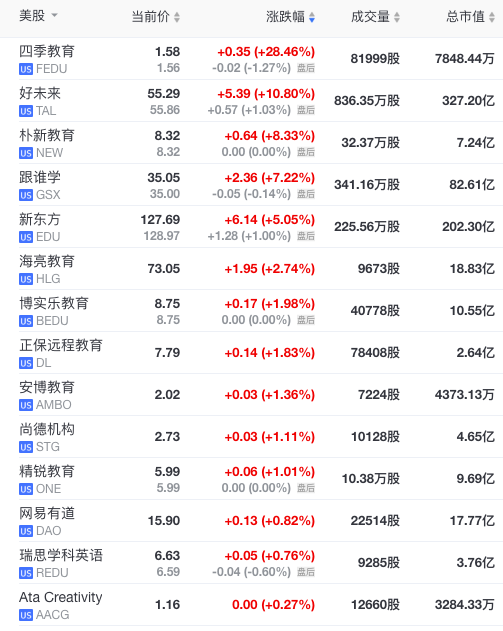51Talk fell nearly 5%.
Compared with the plunge of A shares yesterday, the three major US stock indexes closed up. Among them, the Nasdaq rose 1.34%, the S & P 500 rose 0.73%, and the Dow rose 0.51%. In particular, Tesla rose nearly 20% to $ 780, a record high, with a market value of over $ 140 billion. At the moment when the panic spread, the performance of US stocks has eased investor sentiment to a certain extent.

In terms of the education sector, the stock market has performed very well against the background of the broader market. Among them, Four Seasons Education, Good Future, and Pu Xin Education became the top three gainers, up 28.46%, 10.8%, and 8.33%, respectively. Followed by who to learn and New Oriental, rose 7.22% and 5.05%.
From a technical point of view, despite the highest increase in the four seasons of education, the turnover was only $ 123,700. The stock price base is also very low, with an increase of only $ 0.35. Looking at the future, the turnover is 451 million US dollars, which is almost the sum of the previous two trading days. It is worth mentioning that the good future closed at 55.29 US dollars, only one step away from the historical high of 56.93 US dollars. So last night, the biggest winner in US stocks was a good future, not Four Seasons Education.
From a fundamental point of view, since this section is mainly based on online education, it is in line with the choice of investor targets. The epidemic is not over yet, and students can only learn online at home, thereby ensuring that classes will not be suspended. In comparison, among the top five gainers, only those who learned from them were pure online education companies. The rest basically have different numbers of offline stores. So there is a judgement in it. Compared to pure online education companies, investors are more willing to choose education companies with store support. The logic is that offline has inherently good performance and strong profitability. There is a clear difference from the general loss of online education companies, so during the epidemic, offline students switched to online, and their performance was more stable. Furthermore, it is also increasing its ability to go online and cannibalizing the market share of pure online education companies. Then, for the offline training institutions to fix the labor costs and rent costs, this short-term impact is also a factor that cannot be ignored.